Analysis of Efficient Spectrum Handoff in a Multi-Class Hybrid Spectrum Access Cognitive Radio Network Using Markov Modelling
Abstract
:1. Introduction
Contributions
- The behaviour of primary user activities and its impact on multi-class SUs in hybrid CRN is thoroughly captured through (continuous time Markov chain) CTMC modelling.
- Steady state analysis is performed to analyze spectrum utilization, throughput and extended data delivery time (EDDT) of the system.
- We consider power constrained variable service rate for prioritized multi-class SUs operating in hybrid access CRN.
- A performance comparison of non-switching spectrum handoff for a multi-class SU using hybrid interweave-underlay spectrum access is made with the spectrum handoff in conventional CRN.
- To the best of our knowledge the improvement in extended data delivery time of the delay-sensitive SUs is analyzed by utilizing the steady state Markov analysis in a hybrid CRN with prioritized multi-class SUs with due consideration of power constrained transmission rate for the first time in literature.
2. Related Work
3. System Model
4. Continuous Time Markov Chain Modelling and Steady State Analysis
4.1. Primary Network without CRN (PN-ONLY)
4.2. Primary Network with CRN Having Uni-Class SUs (PN-UC)
4.3. Primary Network with CRN Having Multi-Class SUs in Interweave only Spectrum Access (PN-MC-IW)

4.4. Primary Network with CRN Having Multi-Class SUs in Hybrid Spectrum Access (PN-MC-HB)

5. Simulation and Results
5.1. Steady State Probabilities
5.2. Spectrum Utilization
5.3. Throughput
5.4. Extended Data Delivery Time
6. Conclusions
Author Contributions
Funding
Conflicts of Interest
Abbreviations
| AWGN | Additive White Gaussian Noise |
| CRN | Cognitive Radio Network |
| CTMC | Continuous Time Markov Chain |
| EDDT | Extended Data Delivery Time |
| HMM | Hidden Markov Model |
| MDP | Markov Decision Process |
| NPRP | Non-Preemptive Resume Priority |
| PRP | Preemptive Resume Priority |
| PU | Primary User |
| QoS | Quality of Service |
| SU | Secondary User |
| SINR | Signal to Interference plus Noise Ratio |
| VoIP | Voice over Internet Protocol |
References
- Mitola, J.; Maguire, G.Q. Cognitive radio: Making software radios more personal. IEEE Pers. Commun. 1999, 6, 13–18. [Google Scholar] [CrossRef]
- Akyildiz, I.F.; Lee, W.Y.; Vuran, M.C.; Mohanty, S. NeXt generation/dynamic spectrum access/cognitive radio wireless networks: A survey. Comput. Netw. 2006, 50, 2127–2159. [Google Scholar] [CrossRef]
- Yang, X.; Tan, X.; Ye, L.; Ma, L. Spectrum handoffs based on preemptive repeat priority queue in cognitive radio networks. Sensors 2016, 16, 1127. [Google Scholar] [CrossRef] [PubMed]
- Kumar, K.; Prakash, A.; Tripathi, R. Spectrum handoff in cognitive radio networks: A classification and comprehensive survey. J. Netw. Comput. Appl. 2016, 61, 161–188. [Google Scholar] [CrossRef]
- Wang, L.C.; Wang, C.W.; Chang, C.J. Modeling and analysis for spectrum handoffs in cognitive radio networks. IEEE Trans. Mob. Comput. 2012, 11, 1499–1513. [Google Scholar] [CrossRef]
- Usman, M.; Khan, M.; Vu-Van, H.; Insoo, K. Energy-efficient channel handoff for sensor network-assisted cognitive radio network. Sensors 2015, 15, 18012–18039. [Google Scholar] [CrossRef]
- Zhao, Y.; Yue, W. Cognitive radio networks with multiple secondary users under two kinds of priority schemes: Performance comparison and optimization. J. Ind. Manag. Optim. 2017, 13, 1449–1466. [Google Scholar] [CrossRef]
- Zhang, Y.; Jiang, T.; Zhang, L.; Qu, D.; Peng, W. Analysis on the transmission delay of priority-based secondary users in cognitive radio networks. In Proceedings of the 2013 International Conference on Wireless Communications and Signal Processing, Hangzhou, China, 24–26 October 2013; pp. 1–6. [Google Scholar]
- Lee, Y.; Park, C.G.; Sim, D.B. Cognitive radio spectrum access with prioritized secondary users. Appl. Math. Inf. Sci. 2012, 6, 595S–601S. [Google Scholar]
- Lee, W.Y.; Akyildiz, I.F. Joint spectrum and power allocation for inter-cell spectrum sharing in cognitive radio networks. In Proceedings of the 2008 3rd IEEE Symposium on New Frontiers in Dynamic Spectrum Access Networks, Chicago, IL, USA, 14–17 October 2008; pp. 1–12. [Google Scholar]
- Zheng, K.; Liu, X.Y.; Liu, X.; Zhu, Y. Hybrid Overlay-Underlay Cognitive Radio Networks with Energy Harvesting. IEEE Trans. Commun. 2019, 67, 4669–4682. [Google Scholar] [CrossRef]
- Zhang, R. On peak versus average interference power constraints for protecting primary users in cognitive radio networks. arXiv 2008, arXiv:0806.0676. [Google Scholar] [CrossRef]
- Sharma, S.K.; Bogale, T.E.; Chatzinotas, S.; Ottersten, B.; Le, L.B.; Wang, X. Cognitive radio techniques under practical imperfections: A survey. IEEE Commun. Surv. Tutor. 2015, 17, 1858–1884. [Google Scholar] [CrossRef]
- Bayrakdar, M.E.; Calhan, A. Improving spectrum handoff utilization for prioritized cognitive radio users by exploiting channel bonding with starvation mitigation. AEU Int. J. Electron. Commun. 2017, 71, 181–191. [Google Scholar] [CrossRef]
- Wu, Y.; Hu, F.; Kumar, S.; Guo, M.; Bao, K. Spectrum handoffs with mixed-priority queueing model over cognitive radio networks. In Proceedings of the 2013 IEEE Global Conference on Signal and Information Processing, Austin, TX, USA, 3–5 December 2013; pp. 1194–1197. [Google Scholar]
- Zahed, S.; Awan, I.; Min, G. Prioritized proactive scheme for spectrum handoff decision in cognitive radio networks. In Proceedings of the 2012 Seventh International Conference on Broadband, Wireless Computing, Communication and Applications, Victoria, BC, Canada, 12–14 November 2012; pp. 335–341. [Google Scholar]
- Zhang, L.; Song, T.; Wu, M.; Bao, X.; Guo, J.; Hu, J. Traffic-adaptive proactive spectrum handoff strategy for graded secondary users in cognitive radio networks. Chin. J. Electron. 2015, 24, 844–851. [Google Scholar] [CrossRef]
- Thakur, P.; Kumar, A.; Pandit, S.; Singh, G.; Satashia, S. Performance analysis of high-traffic cognitive radio communication system using hybrid spectrum access, prediction and monitoring techniques. Wirel. Netw. 2018, 24, 2005–2015. [Google Scholar] [CrossRef]
- Bhowmick, A.; Prasad, B.; Roy, S.D.; Kundu, S. Performance of cognitive radio network with novel hybrid spectrum access schemes. Wirel. Pers. Commun. 2016, 91, 541–560. [Google Scholar] [CrossRef]
- Chu, T.M.C.; Zepernick, H.J. Optimal power allocation for hybrid cognitive cooperative radio networks with imperfect spectrum sensing. IEEE Access 2018, 6, 10365–10380. [Google Scholar] [CrossRef]
- Chu, T.M.C.; Phan, H.; Zepernick, H.J. Hybrid interweave-underlay spectrum access for cognitive cooperative radio networks. IEEE Trans. Commun. 2014, 62, 2183–2197. [Google Scholar] [CrossRef]
- Hu, J.; Yang, L.L.; Hanzo, L. Optimal queue scheduling for hybrid cognitive radio maintaining maximum average service rate under delay constraints. In Proceedings of the 2012 IEEE Global Communications Conference (GLOBECOM), Anaheim, CA, USA, 3–7 December 2012; pp. 1398–1403. [Google Scholar]
- Biagi, M.; Cuomo, F. Primary and secondary nodes coexistence through opportunistic MIMO cognitive radio. In Proceedings of the 2012 IEEE Globecom Workshops, Anaheim, CA, USA, 3–7 December 2012; pp. 925–930. [Google Scholar]
- Biagi, M.; Cuomo, F. An opportunistic access scheme through distributed interference control for MIMO cognitive nodes. IEEE Trans. Wirel. Commun. 2013, 12, 6500–6513. [Google Scholar] [CrossRef]
- Wang, B.; Ji, Z.; Liu, K.R.; Clancy, T.C. Primary-prioritized Markov approach for dynamic spectrum allocation. IEEE Trans. Wirel. Commun. 2009, 8, 1854–1865. [Google Scholar] [CrossRef]
- Hu, H.; Zhu, Q. Dynamic spectrum access in underlay cognitive radio system with SINR constraints. In Proceedings of the 2009 5th International Conference on Wireless Communications, Networking and Mobile Computing, Beijing, China, 24–26 September 2009; pp. 1–4. [Google Scholar]
- Mir, U.; Munir, A. An adaptive handoff strategy for cognitive radio networks. Wirel. Netw. 2018, 24, 2077–2092. [Google Scholar] [CrossRef]
- Zahmati, A.S.; Fernando, X.; Grami, A. Steady-state markov chain analysis for heterogeneous cognitive radio networks. In Proceedings of the 2010 IEEE Sarnoff Symposium, Princeton, NJ, USA, 12–14 April 2010; pp. 1–5. [Google Scholar]
- El Azaly, N.M.; Badran, E.F.; Rizk, M.; Mokhtar, M.A. Performance enhancement of steady-state Markov analysis for cognitive radio networks via channel reservation. Alex. Eng. J. 2017, 56, 469–475. [Google Scholar] [CrossRef]
- Tumuluru, V.K.; Wang, P.; Niyato, D.; Song, W. Performance analysis of cognitive radio spectrum access with prioritized traffic. IEEE Trans. Veh. Technol. 2012, 61, 1895–1906. [Google Scholar] [CrossRef]
- Wang, J.W.; Adriman, R. Analysis of opportunistic spectrum access in cognitive radio networks using hidden Markov model with state prediction. EURASIP J. Wirel. Commun. Netw. 2015, 2015, 10. [Google Scholar] [CrossRef] [Green Version]
- Wang, C.W.; Wang, L.C. Analysis of reactive spectrum handoff in cognitive radio networks. IEEE J. Sel. Areas Commun. 2012, 30, 2016–2028. [Google Scholar] [CrossRef]
- Lertsinsrubtavee, A.; Malouch, N. Hybrid spectrum sharing through adaptive spectrum handoff and selection. IEEE Trans. Mob. Comput. 2016, 15, 2781–2793. [Google Scholar] [CrossRef]
- Tan, X.; Zhang, H.; Hu, J. Achievable transmission rate of the secondary user in cognitive radio networks with hybrid spectrum access strategy. IEEE Commun. Lett. 2013, 17, 2088–2091. [Google Scholar] [CrossRef]
- Yang, J.; Zhao, H. Enhanced throughput of cognitive radio networks by imperfect spectrum prediction. IEEE Commun. Lett. 2015, 19, 1738–1741. [Google Scholar] [CrossRef]
- Arjoune, Y.; Kaabouch, N. A comprehensive survey on spectrum sensing in cognitive radio networks: Recent advances, new challenges, and future research directions. Sensors 2019, 19, 126. [Google Scholar] [CrossRef]
- Kulkarni, V.G. Modeling and Analysis of Stochastic Systems; Chapman and Hall/CRC: Boca Raton, FL, USA, 2016. [Google Scholar]
- Tang, W.; Imran, M.A.; Tafazolli, R. Spectrum utilization efficiency analysis in cognitive radio networks. In Proceedings of the European Wireless 2013; 19th European Wireless Conference, Guildford, UK, 16–18 April 2013; VDE: Berlin, Germany, 2013; pp. 1–5. [Google Scholar]
- Zhou, Y. New Spectrum Utilization Efficiency Metrics for Coexistence and Spectrum Sharing Applications. In Proceedings of the 2017 IEEE 86th Vehicular Technology Conference (VTC-Fall), Toronto, ON, Canada, 24–27 September 2017; pp. 1–5. [Google Scholar]
- Xing, Y.; Chandramouli, R.; Mangold, S. Dynamic spectrum access in open spectrum wireless networks. IEEE J. Sel. Areas Commun. 2006, 24, 626–637. [Google Scholar] [CrossRef] [Green Version]


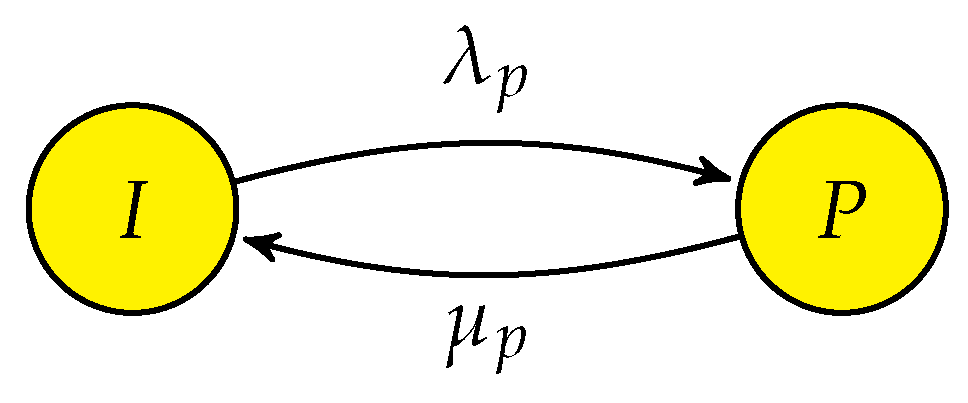
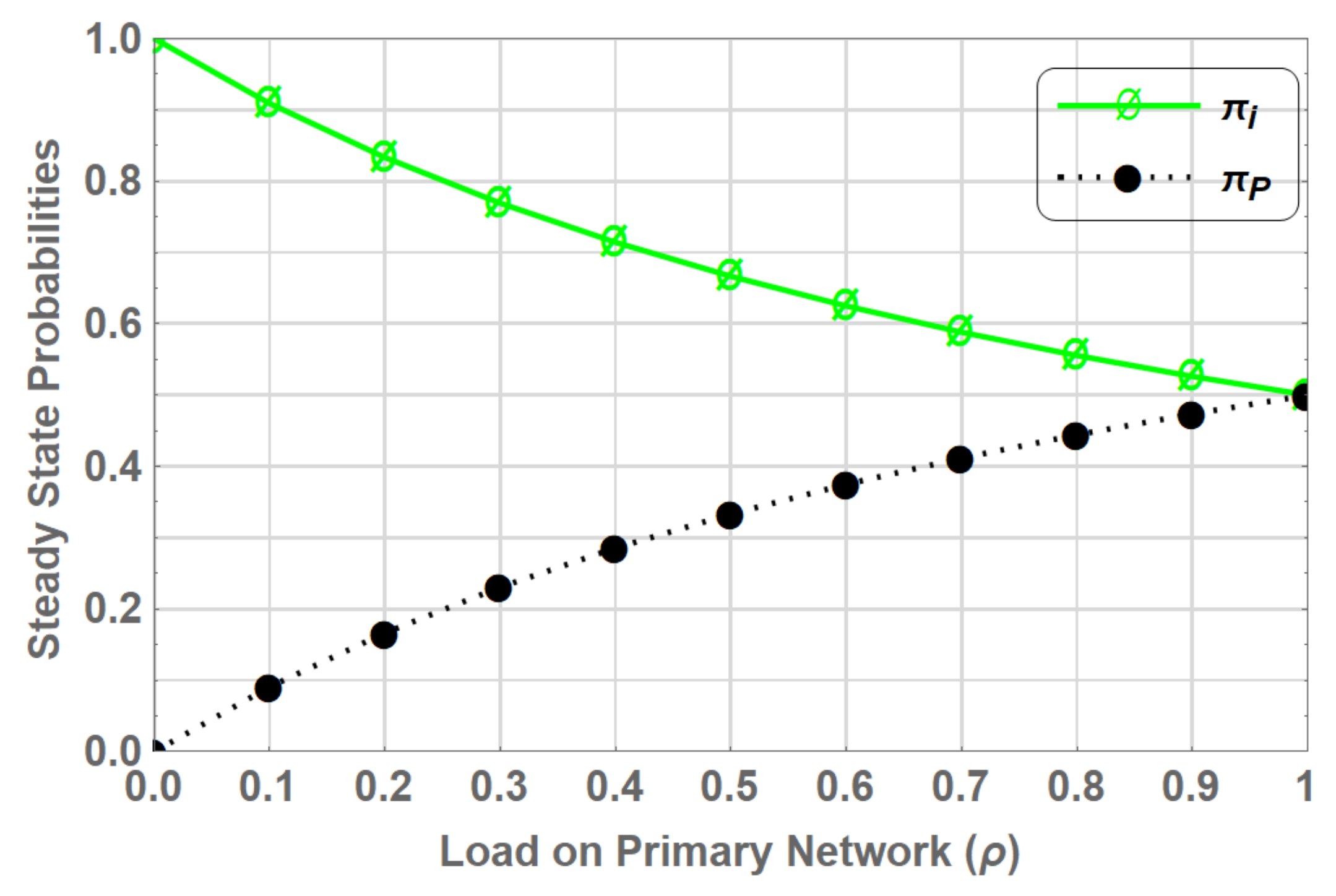


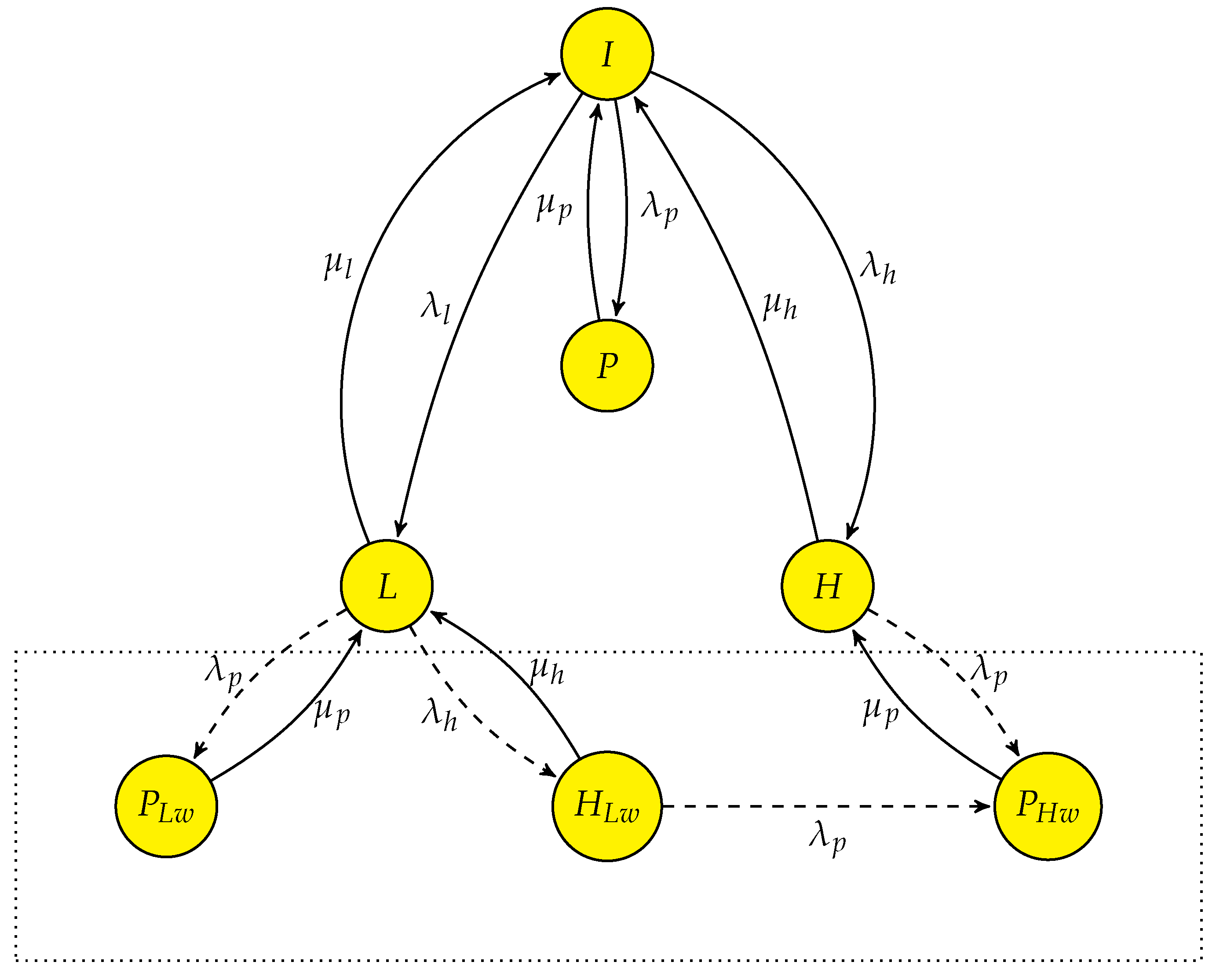

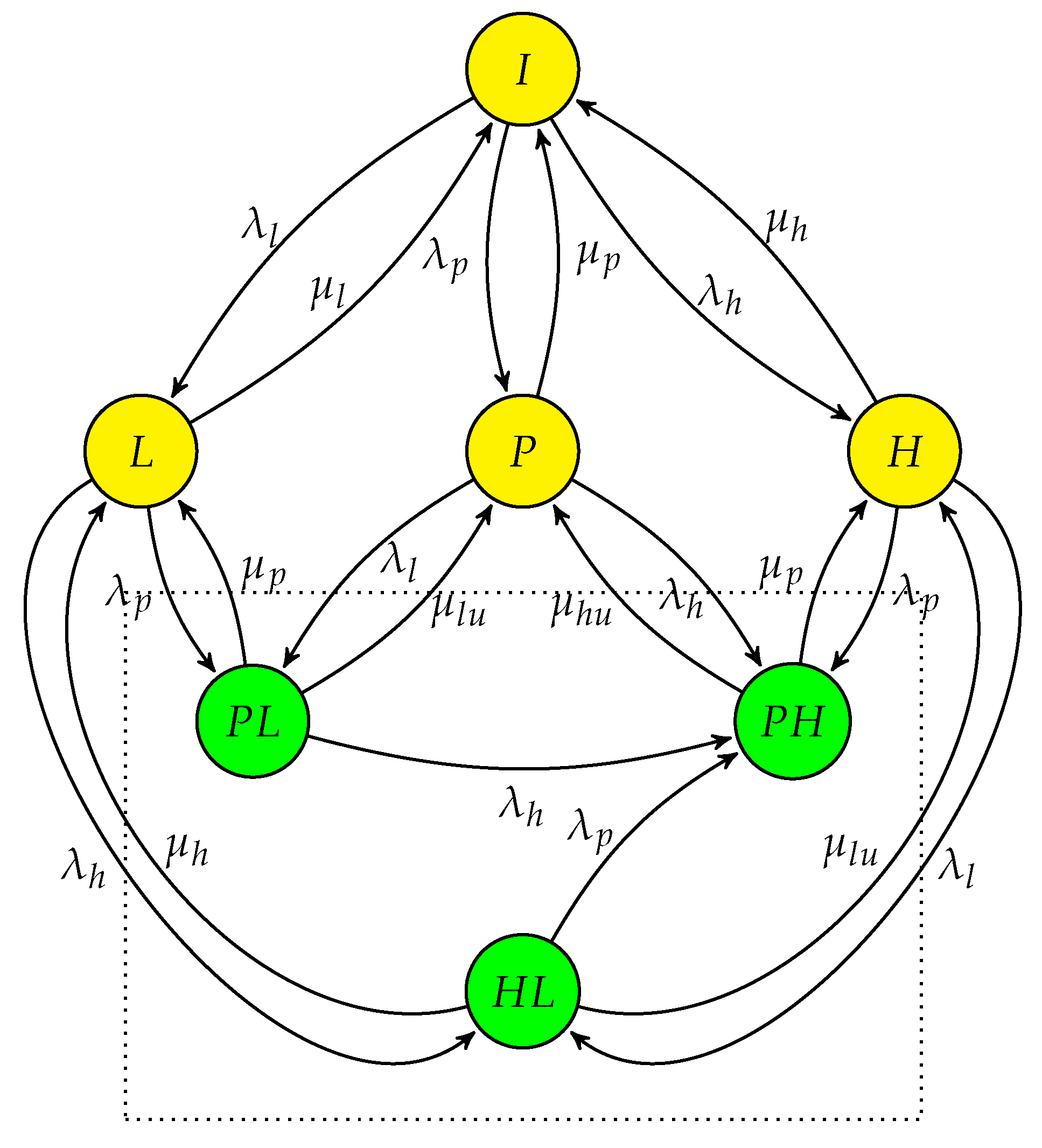
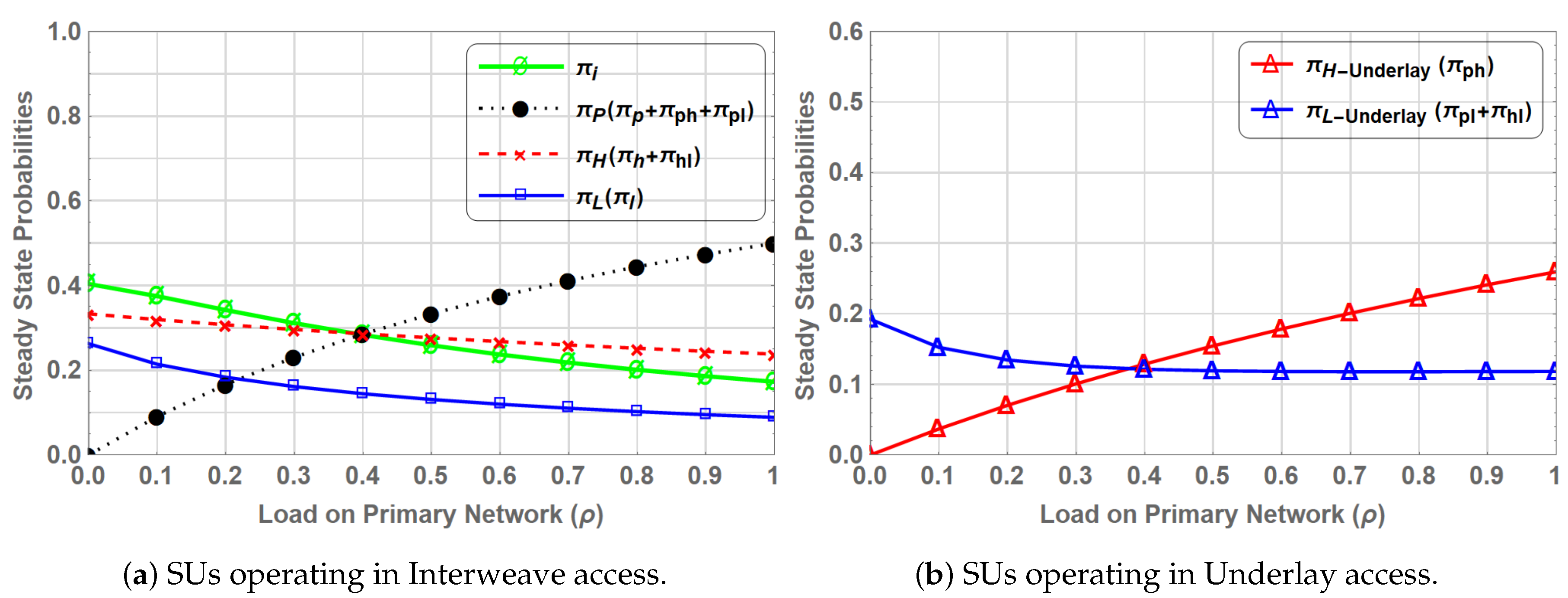
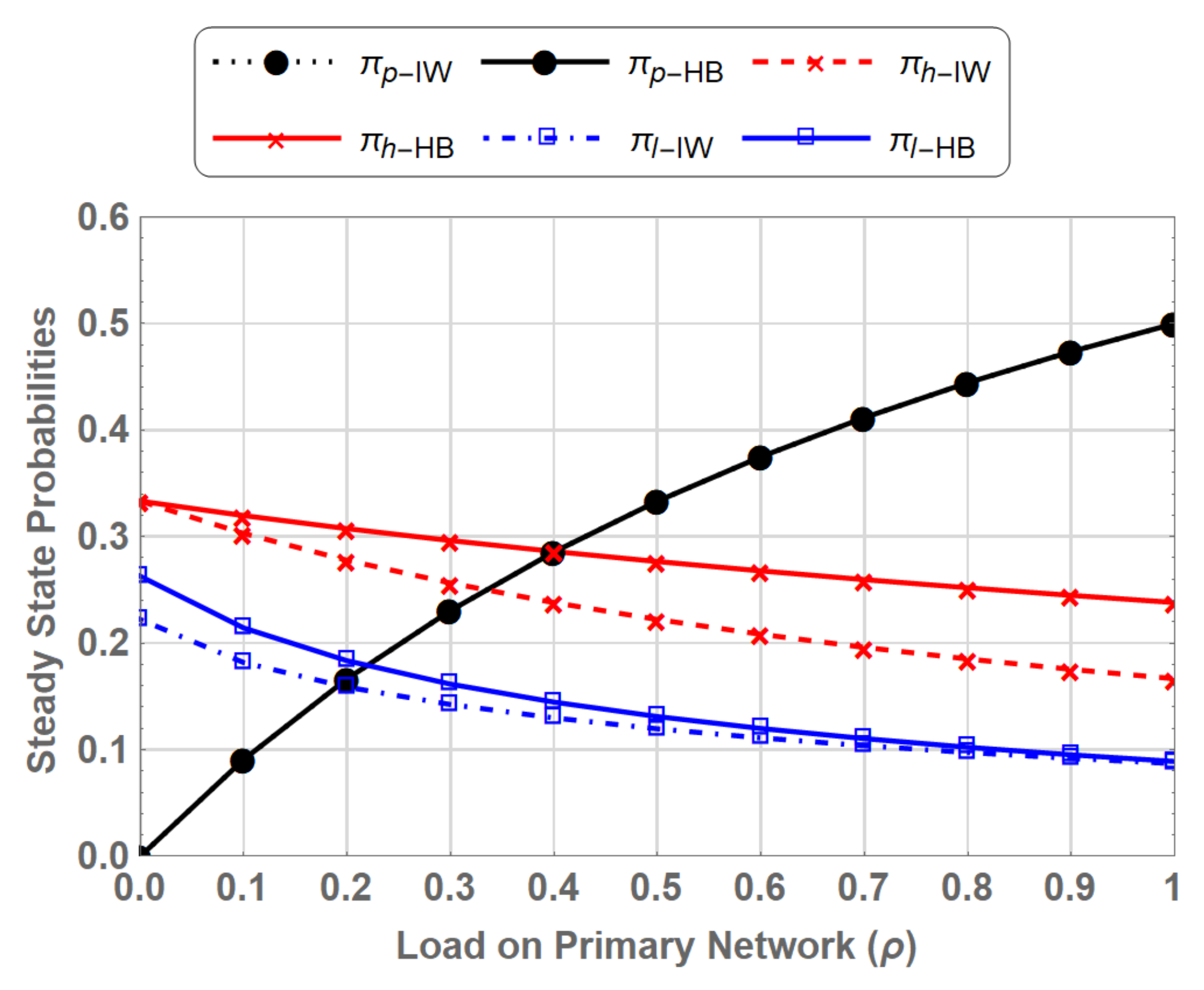
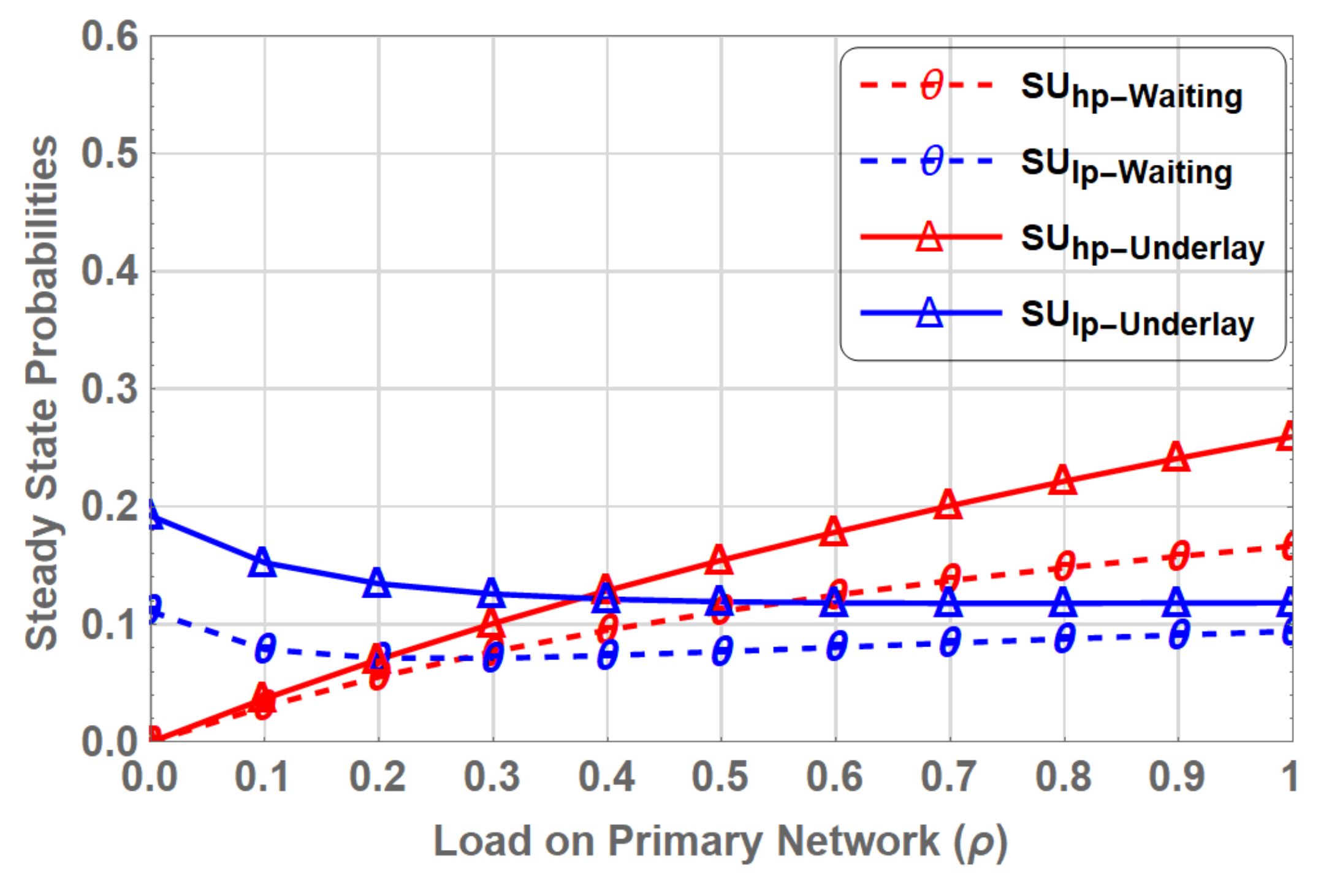
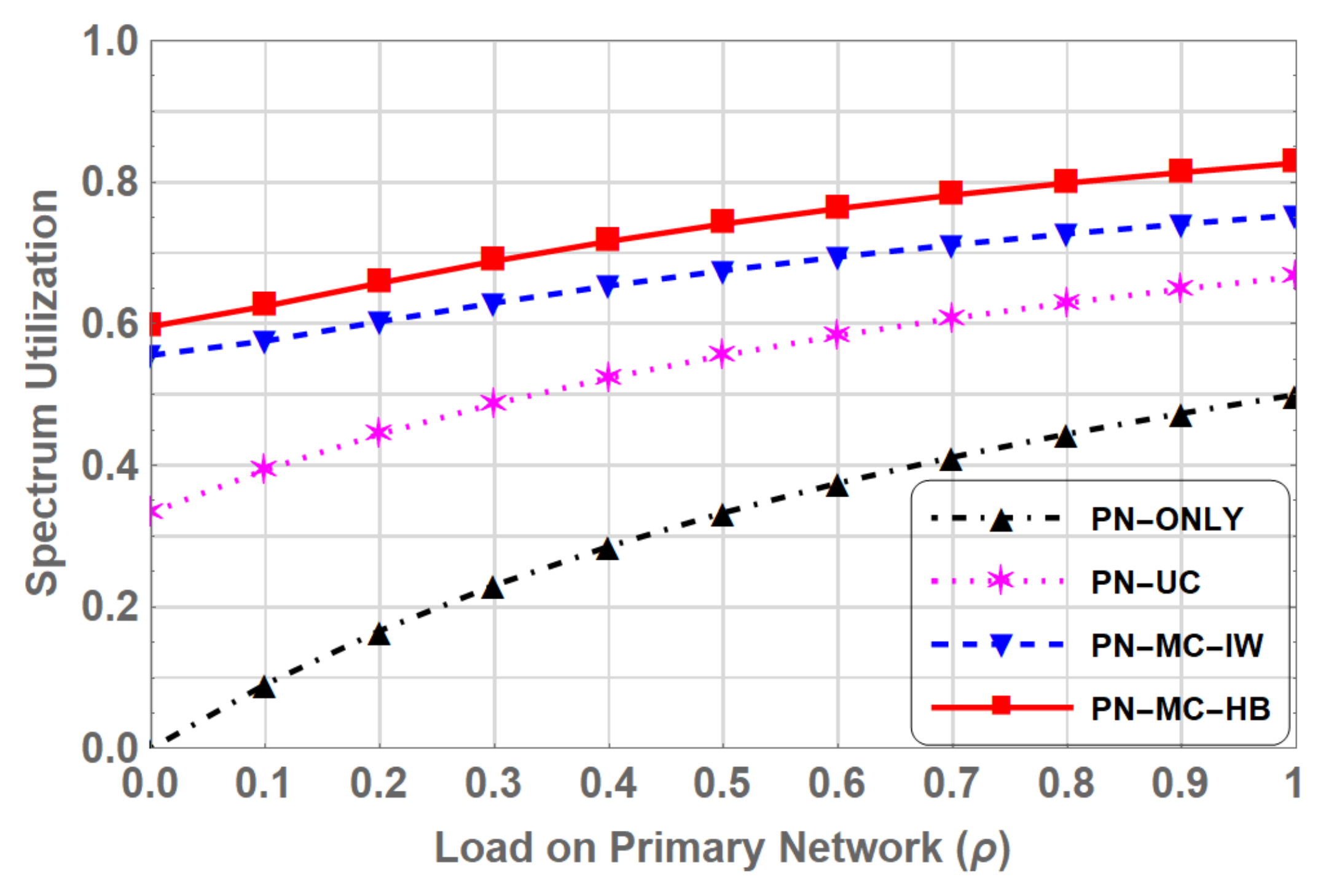



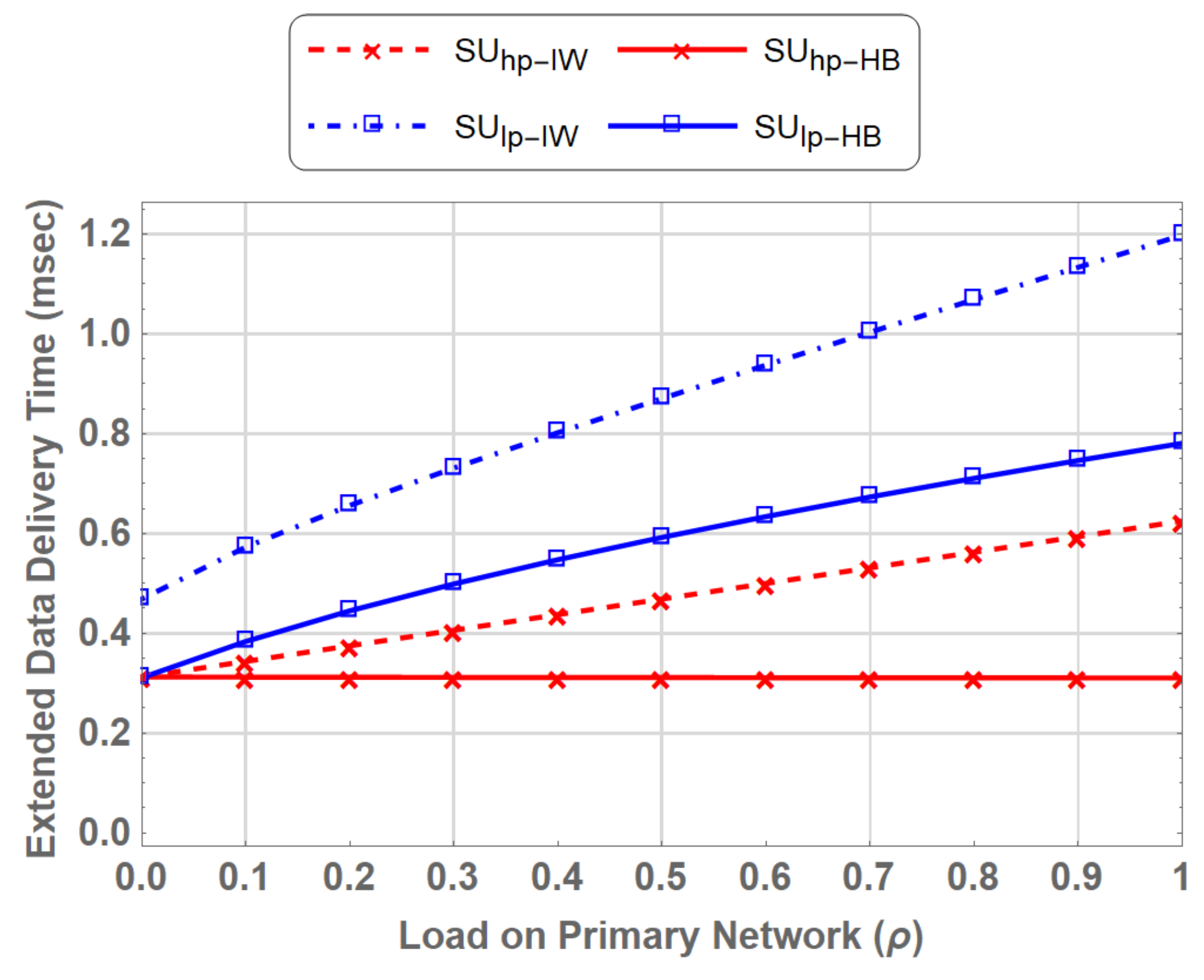
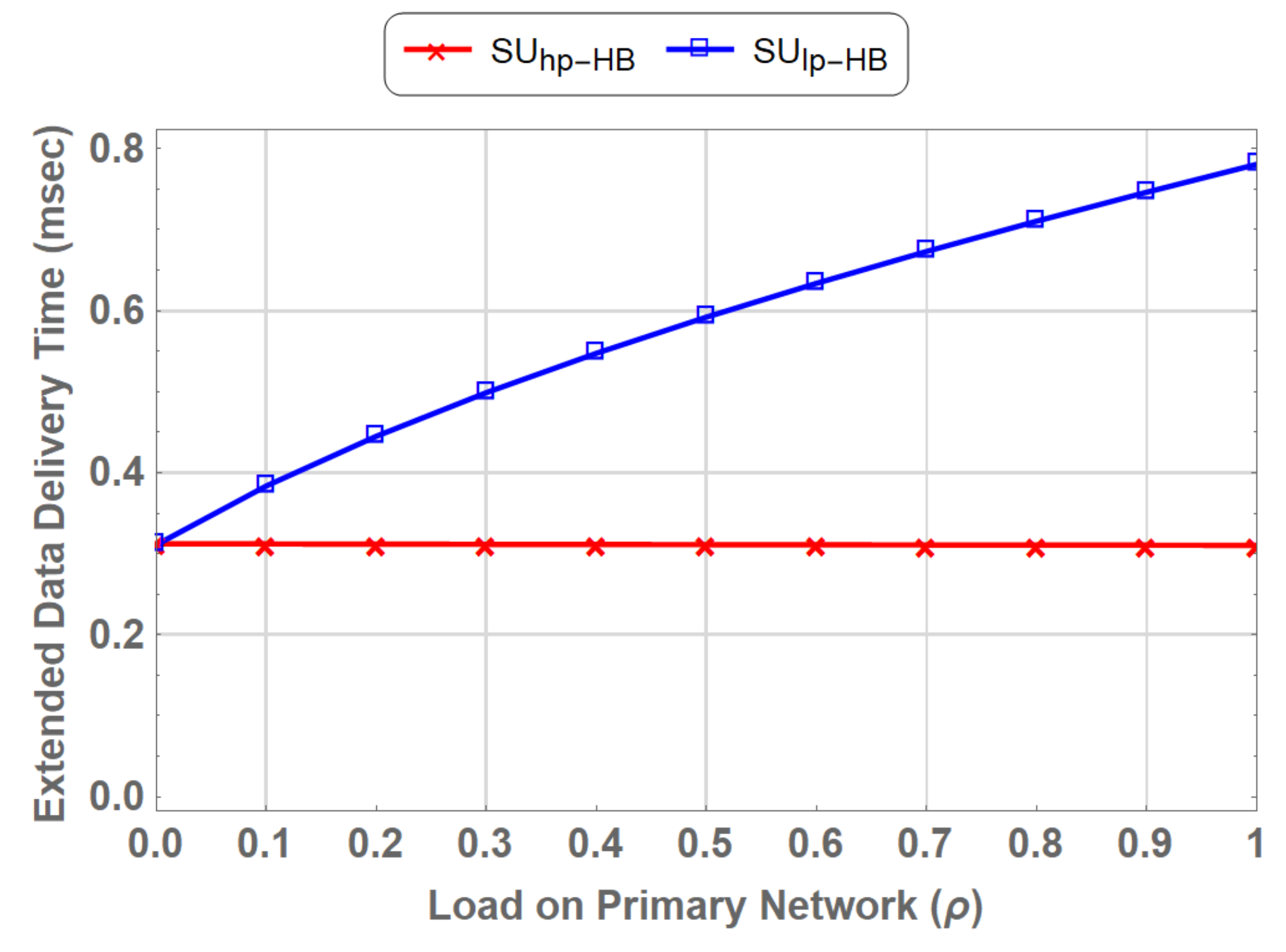
| Hybrid Interweave Underlay Spectrum Access | Markov-Based Modelling and Analysis | Prioritized Multi Class SU Traffic | Consideration of Power Constrained Data Rate in Underlay Access | Throughput | Delay | |
|---|---|---|---|---|---|---|
| Bayrakdar et al. [14] | ✗ | ✗ | ✓ | ✗ | ✗ | ✓ |
| Wu Yeqing et al. [15] | ✗ | ✗ | ✓ | ✗ | ✗ | ✓ |
| Zahed Salah et al. [16] | ✗ | ✗ | ✓ | ✗ | ✗ | ✓ |
| Zhang Lei et al. [17] | ✗ | ✗ | ✓ | ✗ | ✗ | ✗ |
| P. Thakur et al. [18] | ✓ | ✗ | ✗ | ✓ | ✓ | ✗ |
| A. Bhowmick et al. [19] | ✓ | ✗ | ✗ | ✓ | ✓ | ✗ |
| Chu Thi et al. [20,21] | ✓ | ✓ | ✗ | ✓ | ✓ | ✗ |
| Jie Hu et al. [22] | ✓ | ✗ | ✗ | ✓ | ✗ | ✓ |
| F.Cuomo et al. [23,24] | ✓ | ✗ | ✗ | ✓ | ✗ | ✗ |
| Wang Beibei et al. [25] | ✓ | ✗ | ✗ | ✓ | ✓ | ✗ |
| Hu Han et al. [26] | ✓ | ✓ | ✗ | ✗ | ✗ | ✗ |
| Osama Mir et al. [27] | ✗ | ✓ | ✗ | ✗ | ✓ | ✓ |
| A. Zahmati et al. [28] | ✓ | ✗ | ✗ | ✗ | ✓ | ✗ |
| El Azaly et al. [29] | ✗ | ✓ | ✗ | ✗ | ✗ | ✗ |
| V. Tumuluru et al. [30] | ✗ | ✓ | ✓ | ✗ | ✗ | ✓ |
| Proposed | ✓ | ✓ | ✓ | ✓ | ✓ | ✓ |
| System Parameters | |
|---|---|
| No. of Primary Channel () | 1 |
| Load on primary network () | [0.0–1.0] |
| Mean SU arrival rate () | 2 |
| Mean High Priority () arrival rate () | 1 |
| Mean Low Priority () arrival rate () | 1 |
| Mean SU Departure rate () | 4 |
| Mean High Priority () Departure rate () | 2 |
| Mean Low Priority () Departure rate () | 2 |
| Mean High Priority () Departure rate - underlay () | 0.01 |
| Mean Low Priority () Departure rate - underlay () | 0.01 |
| File Size () | 5 Kbit |
| Transmission rate (IEEE 802.11a) - Interweave () | 48 Mbps |
| Transmission rate (IEEE 802.11a) - Underlay () | 18 Mbps |
| Channel Bandwidth (IEEE 802.11a) (W) | 22 MHz |
© 2019 by the authors. Licensee MDPI, Basel, Switzerland. This article is an open access article distributed under the terms and conditions of the Creative Commons Attribution (CC BY) license (http://creativecommons.org/licenses/by/4.0/).
Share and Cite
Shakeel, A.; Hussain, R.; Iqbal, A.; Khan, I.L.; Hasan, Q.u.; Malik, S.A. Analysis of Efficient Spectrum Handoff in a Multi-Class Hybrid Spectrum Access Cognitive Radio Network Using Markov Modelling. Sensors 2019, 19, 4120. https://doi.org/10.3390/s19194120
Shakeel A, Hussain R, Iqbal A, Khan IL, Hasan Qu, Malik SA. Analysis of Efficient Spectrum Handoff in a Multi-Class Hybrid Spectrum Access Cognitive Radio Network Using Markov Modelling. Sensors. 2019; 19(19):4120. https://doi.org/10.3390/s19194120
Chicago/Turabian StyleShakeel, Atif, Riaz Hussain, Adeel Iqbal, Irfan Latif Khan, Qadeer ul Hasan, and Shahzad Ali Malik. 2019. "Analysis of Efficient Spectrum Handoff in a Multi-Class Hybrid Spectrum Access Cognitive Radio Network Using Markov Modelling" Sensors 19, no. 19: 4120. https://doi.org/10.3390/s19194120







